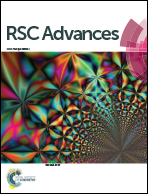Characterization of three depside compounds from a Western Ghat lichen Parmelia erumpens Kurok with special reference to antimicrobial and anticancer activity
Abstract
The aim of this study was to investigate the major chemical compositions of the chloroform extract of lichen Parmelia erumpens from Western Ghats, Kerala, India and its antimicrobial and anticancer activities. Chloroform extract was purified by silica gel column chromatography to obtain three major compounds and their chemical structures were characterized by 1H-NMR, 13C-NMR, UV and HR-MS spectroscopic methods as atranorin (1), (+)-usnic acid (2) and 2-hydroxy-4-methoxy-3,6-dimethylbenzoic acid (3). The minimal inhibitory concentration (MIC) by the broth micro dilution and agar disc diffusion methods was used to record the antimicrobial activity. Out of three compounds tested, 2-hydroxy-4-methoxy-3,6-dimethylbenzoic acid recorded excellent antimicrobial activity especially against medically important bacteria and fungi and the MIC values ranged from 0.06 to 4 μg ml−1 against test bacteria and 0.12 to 16 μg ml−1 against test fungi. The best MIC of 0.06 μg ml−1 by 2-hydroxy-4-methoxy-3,6-dimethylbenzoic acid was recorded against Vibrio cholera, a human pathogenic bacterium responsible for causing life threatening diseases like profuse watery diarrhea. Anti cancer activity was initially screened by MTT assay in A549, B16F10, Caski and HepG2 cell lines. MTT assay results showed that the growth of cancer cells was suppressed by 2-hydroxy-4-methoxy-3,6-dimethylbenzoic acid in both dose- and time-dependent manners. A549, B16F10 and Caski cells treated with 2-hydroxy-4-methoxy-3,6-dimethylbenzoic acid showed typical apoptotic morphology when stained with acridine orange–ethidium bromide and hoechst staining. Cell cycle analysis clearly indicated that cell death was due to apoptosis. Enhancement in the proliferation of lymphocytes suggested immunomodulatory activity of this compound. To our best knowledge anticancer activity of 2-hydroxy-4-methoxy-3,6-dimethylbenzoic acid was reported here for the first time. Thus the results of the present study suggest that 2-hydroxy-4-methoxy-3,6-dimethylbenzoic acid has a strong potential to be developed as an antimicrobial and anticancer drug target after further clinical evaluation.


 Please wait while we load your content...
Please wait while we load your content...